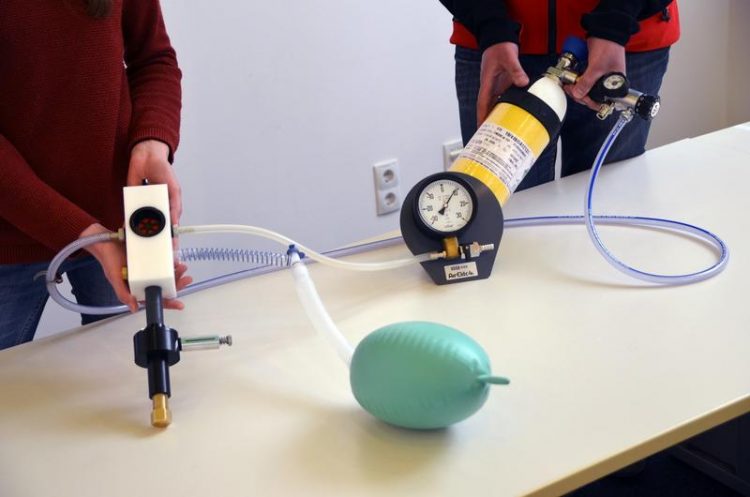Scientists at TU Bergakademie Freiberg develop new ways of emergency ventilation

The first prototype of the pressure-controlled emergency ventilator. Photo: Dr. Robert Szlosarek
To this end, the mine rescue team of TU Bergakademie Freiberg and the Institute for Machine Elements, Design and Production have combined their expertise.
“We know how ventilators work and Prof. Matthias Kröger and his design team know how to build such devices”, explains Frank Reuter, head of mine operations in the research and training mine “Reiche Zeche” at TU Freiberg.
The first prototype has already been produced and is currently undergoing various tests to check and further improve its functions. No electricity is required to operate the emergency ventilator, only compressed air or oxygen.
It mainly consists of a control piston with which different parameters, such as the ventilation pressures during inhalation and exhalation (PIP, PEEP) or the respiratory rate, can be adjusted.
In addition, the oxygen concentration can be optionally controlled. Those are important factors to be able to ventilate emergency patients who have been infected with a lung disease.
The scientists from Freiberg focus mainly on the supply of lung care in poorer countries with little technical know-how and a high population density.
“Our prototype is designed in such a way that it can be reproduced, maintained and cleaned with simple means and a few tools,” explains Dr. Robert Szlosarek from the Chair for Machine Elements at the TU Bergakademie Freiberg.
The scientists would like to communicate their idea to groups engaged in development aid and embassies.
Prof. Matthias Kröger, Phone: +49 3731/39-2997
Media Contact
More Information:
http://www.tu-freiberg.de/All latest news from the category: Medical Engineering
The development of medical equipment, products and technical procedures is characterized by high research and development costs in a variety of fields related to the study of human medicine.
innovations-report provides informative and stimulating reports and articles on topics ranging from imaging processes, cell and tissue techniques, optical techniques, implants, orthopedic aids, clinical and medical office equipment, dialysis systems and x-ray/radiation monitoring devices to endoscopy, ultrasound, surgical techniques, and dental materials.
Newest articles

How marine worms regenerate lost body parts
The return of cells to a stem cell-like state as the key to regeneration. Many living organisms are able to regenerate damaged or lost tissue, but why some are particularly…

Nano-scale molecular detective
New on-chip device uses exotic light rays in 2D material to detect molecules. Researchers have developed a highly sensitive detector for identifying molecules via their infrared vibrational “fingerprint”. Published in Nature…

Novel CAR T-cell therapy
… demonstrates efficacy and safety in preclinical models of HER2-positive solid tumors. The p95HER2 protein is found expressed in one third of HER2+ tumors, which represent 4% of all tumors….



